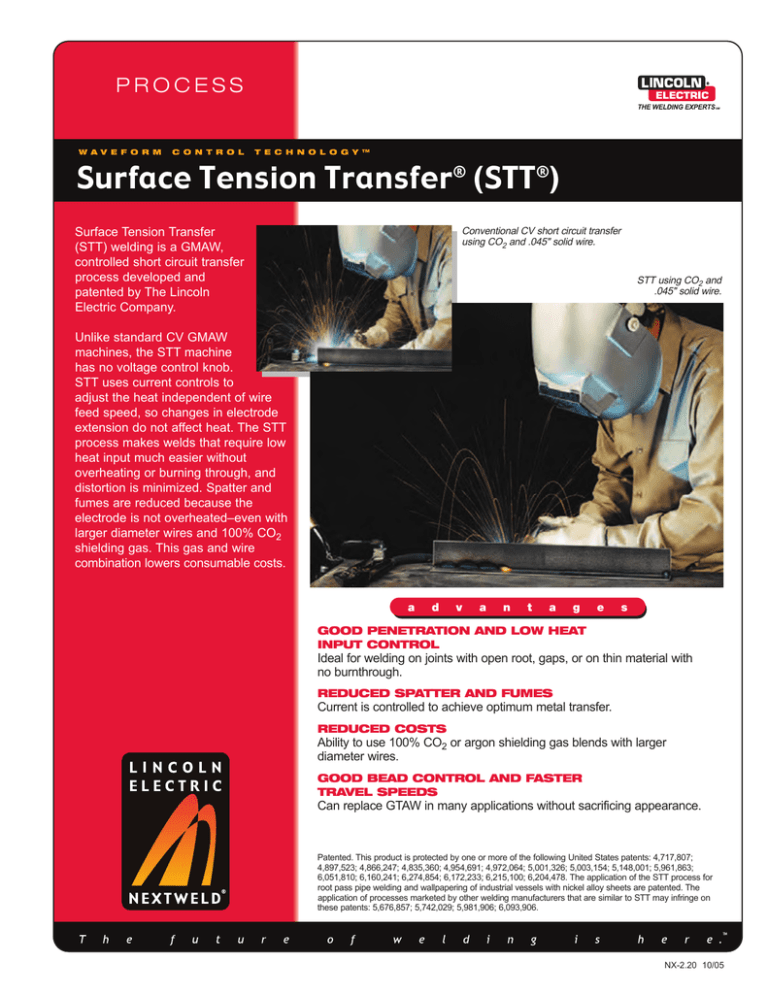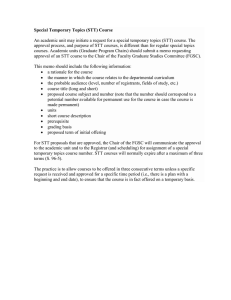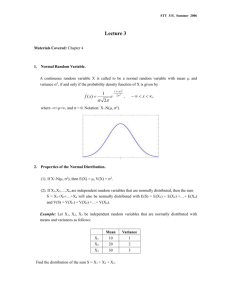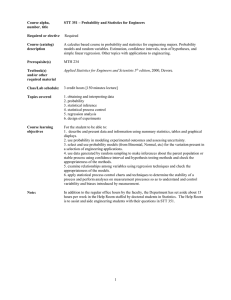Surface Tension Transfer STT Waveform Control
advertisement

PROCESS Surface Tension Transfer ® (STT ®) W A V E F O R M C O N T R O L T E C H N O L O G Y ™ Conventional CV short circuit transfer using CO2 and .045" solid wire. Surface Tension Transfer (STT) welding is a GMAW, controlled short circuit transfer process developed and patented by The Lincoln Electric Company. STT using CO2 and .045" solid wire. Unlike standard CV GMAW machines, the STT machine has no voltage control knob. STT uses current controls to adjust the heat independent of wire feed speed, so changes in electrode extension do not affect heat. The STT process makes welds that require low heat input much easier without overheating or burning through, and distortion is minimized. Spatter and fumes are reduced because the electrode is not overheated–even with larger diameter wires and 100% CO2 shielding gas. This gas and wire combination lowers consumable costs. a d v a n t a g e s GOOD PENETRATION AND LOW HEAT INPUT CONTROL Ideal for welding on joints with open root, gaps, or on thin material with no burnthrough. REDUCED SPATTER AND FUMES Current is controlled to achieve optimum metal transfer. REDUCED COSTS Ability to use 100% CO2 or argon shielding gas blends with larger diameter wires. GOOD BEAD CONTROL AND FASTER TRAVEL SPEEDS Can replace GTAW in many applications without sacrificing appearance. Patented. This product is protected by one or more of the following United States patents: 4,717,807; 4,897,523; 4,866,247; 4,835,360; 4,954,691; 4,972,064; 5,001,326; 5,003,154; 5,148,001; 5,961,863; 6,051,810; 6,160,241; 6,274,854; 6,172,233; 6,215,100; 6,204,478. The application of the STT process for root pass pipe welding and wallpapering of industrial vessels with nickel alloy sheets are patented. The application of processes marketed by other welding manufacturers that are similar to STT may infringe on these patents: 5,676,857; 5,742,029; 5,981,906; 6,093,906. NX-2.20 10/05 Surface Tension Transfer (STT) W A V E F O R M C O N T R O L How PROCESS T E C H N O L O G Y ™ 2/4 THE STT PROCESS STT works A BACKGROUND CURRENT between 50 and 100 amps maintains the arc and contributes to base metal heating. After the electrode initially shorts to the weld pool, the current is quickly reduced to ensure a solid short. PINCH CURRENT is then applied to squeeze molten metal down into the pool while monitoring the necking of the liquid bridge from electrical signals. When the liquid bridge is about to break, the power source reacts by reducing the current to about 45-50 amps. Immediately following the arc re-establishment, a PEAK CURRENT is applied to produce plasma force pushing down the weld pool to prevent accidental short and to heat the puddle and the joint. Finally, exponential TAIL-OUT is adjusted to regulate overall heat input. BACKGROUND CURRENT serves as a fine heat control. A. STT produces a uniform molten ball and maintains it until the “ball” shorts to the puddle. PEAK TIME PEAK CURRENT PINCH CURRENT TAIL-OUT SPEED BACKGROUND CURRENT A B. When the “ball” shorts to the puddle, the current is reduced to a low level allowing the molten ball to wet into the puddle. B C D E C. Automatically, a precision D. STT circuitry re-establishes PINCH CURRENT waveform the welding arc at a low is applied to the short. During current level. this time, special circuitry determines that the short is about to break and reduces the current to avoid the spatter producing “explosion”. The TAIL-OUT CONTROL adjusts the rate that the current is changed from PEAK to BACKGROUND. Basically, the TAIL-OUT is a coarse heat control. A E. STT circuitry senses that the arc is re-established, and automatically applies PEAK CURRENT, which sets the proper arc length. Following PEAK CURRENT, internal circuitry automatically switches to the BACKGROUND CURRENT, which serves as a fine heat control. Surface Tension Transfer (STT) W A V E F O R M C O N T R O L T E C H N O L O G Y ™ Comparing Advantages of STT replacing GTAW: • Four times faster • Vertical down welding • Shorter training time • Can use various compositions of shielding gas • 100% CO2 (on mild steel) • Welds stainless, nickel alloys and mild steel • Consistent x-ray quality welds When to use STT STT is the process of choice for low heat input welds. STT is also ideal for: • Open root – pipe and plate. • Stainless steel & other nickel alloys – petrochemical utility and food industry. • Thin gauge material – automotive. • Silicon bronze – automotive. • Galvanized steel. • Semi-automatic and robotic applications. Utilizing STT on Lincoln Welding Systems Adjust WIRE FEED SPEED to: • control the deposition rate. Adjust PEAK CURRENT to: • control the arc length. Adjust BACKGROUND CURRENT to: • control heat input (fine). Adjust TAIL-OUT to: • control heat input (coarse). Adjust HOT START to: • control the heat (current) at the start of the arc. 3/4 LINCOLN WELDING SYSTEMS F E AT U R I N G S T T STT to conventional processes Advantages of STT replacing short-arc GMAW: • Eliminates lack of fusion • Good puddle control • Consistent X-ray quality welds • Shorter training time • Low fume generation & spatter • Can use various compositions of shielding gas • 100% CO2 (on mild steel) PROCESS LN-742 The LN-742 semiautomatic wire feeder features a trigger mode selection for 2-step or 4-step and time controls for burn-back, spot times and preflow/post-flow shielding gas. Two-roll wire drive for positive wire feeding. Dynamic braking system minimizes crater sticking problems. Tool-less quick release wire drive tension system for easy wire or gun changes. LN-15 LN-15 is one of the smallest and most maneuverable wire feeders available on the market today. Control Cable model includes STT capabilities and is compatible with the STT II power source for outstanding welding performance including pulse welding on a wide variety of steel, stainless steel, aluminum and alloy materials. STT-10 The sophisticated STT-10 Process Controller was designed specifically to work with the revolutionary STT II power source. Microprocessor controls make it easy to develop optimal procedures and set the range of operator adjustments. Dual procedure control can increase or decrease the energy in the arc without changing the wire feed speed. Surface Tension Transfer (STT) W A V E F O R M C O N T R O L T E C H N O L O G Y ™ Lincoln Welding Systems featuring STT (cont.) Invertec® STT II The STT II combines high frequency inverter technology with advanced Waveform Control Technology in place of traditional short-arc GMAW welding. The STT II’s precise control of the electrode current during the entire welding cycle significantly reduces fumes, spatter and grinding time. In addition, the unit offers independent control of wire feed speed and current. Power Wave® 455M/STT/Power Feed 10M Dual The Power Wave 455M/STT is a digitally controlled inverter power source capable of complex, high-speed waveform control. It is designed to be part of a modular, multiprocess welding system. By installing various modular options, the power sources can be reconfigured to be used in robotic or hard automation systems, and can communicate with other industrial machines to create a highly integrated and flexible welding cell. Power Wave 455M/STT Power Feed 10R Robotic The Power Feed 10R is a high performance, digitally controlled, modular wire feeder designed to be a part of a modular, multi-process welding system. It is specifically designed to mount to a robot arm or to use in hard automation applications. This four drive roll feeder operates on 40VDC input power and is designed to be used with ArcLink™ Robotic Power Waves. PROCESS 4/4 W H AT I S N E X T W E L D ? The challenges facing industrial fabricators today are increasingly difficult. Rising labor, material, and energy costs, intense domestic and global competition, a dwindling pool of skilled workers, more stringent and specific quality demands. Through our commitment to extensive research and investments in product development, Lincoln Electric has established an industry benchmark for applying technology to improve the quality, lower the cost and enhance the performance of arc welding processes. Advancements in power electronics, digital communications and Waveform Control TechnologyTM are the foundation for many of the improvements. NEXTWELD brings you a series of Process, Technology, Application and Success Story documents like this one. NEXTWELD explains how technologies, products, processes and applications are linked together to answer the important questions that all businesses face: • How can we work faster, work smarter, work more efficiently? • How can we get equipment and people to perform in ways they’ve never had to before? • How do we stay competitive? • How do we maintain profitability? Customer Assistance Policy The business of The Lincoln Electric Company is manufacturing and selling high quality welding equipment, consumables, and cutting equipment. Our challenge is to meet the needs of our customers and to exceed their expectations. On occasion, purchasers may ask Lincoln Electric for advice or information about their use of our products. We respond to our customers based on the best information in our possession at that time. Lincoln Electric is not in a position to warrant or guarantee such advice, and assumes no liability, with respect to such information or advice. We expressly disclaim any warranty of any kind, including any warranty of fitness for any customer’s particular purpose, with respect to such information or advice. As a matter of practical consideration, we also cannot assume any responsibility for updating or correcting any such information or advice once it has been given, nor does the provision of information or advice create, expand or alter any warranty with respect to the sale of our products. NEXTWELD is the future of welding but its benefits are available to you today. Ask your Lincoln Electric representative how to improve the flexibility, efficiency and quality of your welding operations to reduce your cost of fabrication. Lincoln Electric is a responsive manufacturer, but the selection and use of specific products sold by Lincoln Electric is solely within the control of, and remains the sole responsibility of the customer. Many variables beyond the control of Lincoln Electric affect the results obtained in applying these types of fabrication methods and service requirements. Subject to change – This information is accurate to the best of our knowledge at the time of printing. Please refer to www.lincolnelectric.com for any updated information. Test Results Disclaimer Test results for mechanical properties, deposit or electrode composition and diffusible hydrogen levels were obtained from a weld produced and tested according to prescribed standards, and should not be assumed to be the expected results in a particular application or weldment. Actual results will vary depending on many factors, including, but not limited to, weld procedure, plate chemistry and temperature, weldment design and fabrication methods. Users are cautioned to confirm by qualification testing, or other appropriate means, the suitability of any welding consumable and procedure before use in the intended application. THE LINCOLN ELECTRIC COMPANY www.lincolnelectric.com 1.216.481.8100





